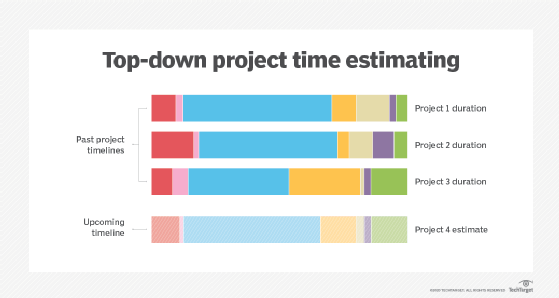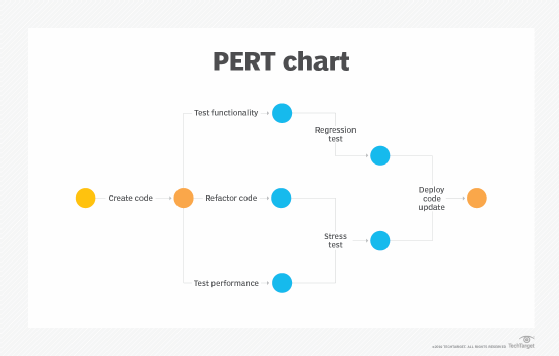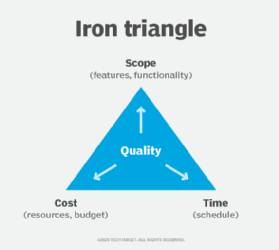
peshkova - Fotolia
How to calculate project completion times
Good project managers deliver on schedule, despite the challenges they encounter. Become a time and resource management pro and deliver on the expected completion date.
"How long will this take?" and "When can we deliver?" are two of the most-asked questions project managers face. Experienced project managers know how to calculate project completion times, then offer crisp responses, such as "two weeks," "three sprints" or "on X date." Senior management and clients expect these definitive responses. Project managers that provide consistent time estimates set themselves apart from their peers.
The ability to calculate how long development takes is -- and should be -- a core indicator of project manager competence. To get it right, account for all known project dependencies in the project delivery timeline estimate. Of course, unexpected events can occur that throw off the project time estimation. For example, a change to the business mission will affect the project schedule and require refinement of the expected timeline.
Project managers should learn common time estimation methods, including top-down, parametric formulas and the iron triangle control. Then, see how to plan for large, multipart projects. Finally, get advice on how to keep everyone on track.
3 essential time estimating methods
There are several proven methods to calculate project completion times, each aligned to the development method in use:
- Top-down estimating. This time management estimate technique is most reliable when similar projects or tasks occurred in the past and the team members making estimates have the expertise from them.
- Parametric formulas. This technique uses relationships between variables, calculating a unit duration and using a multiplier. One example is a PERT chart, which is used to estimate time when there is a high level of uncertainty in the project's tasks.
- Iron triangle control. This estimating method visualizes resources, scope and time as three corners of a triangle to predict or set delivery dates for the entire project.
The top-down time estimation method substantially relies on the experience of the project manager and team members, as well as subject matter knowledge about the work to be performed. Top-down estimating looks to prior projects for comparable tasks the team completed. Then, the team can estimate the project completion date or total time based upon these historical task lengths.

Parametric formulas, such as PERT, base the project time estimation on a range of durations for task completion. PERT uses a formula that establishes how to estimate project completion time. It combines the optimistic time (shortest possible project duration), the pessimistic time (longest duration) and the most likely time into a weighted average. Here is the starting point of the PERT calculation:
Expected time = (optimistic + (4x most likely) + pessimistic) / 6
The project manager collaborates with team members to estimate the optimistic, most likely and pessimistic durations. Plug these time estimations into the formula to get an overall project time range.
For example, the optimistic project duration is 10 days, while the most likely duration is 12 days and a pessimistic duration could be 17 days. Thus, the expected time completion formula is:
Expected time = (10+(4x12)+17)/6 or 12.5 days

If these three total duration assessments have a large spread, subtract the optimistic value from the pessimistic value and divide the result by six. The result is the standard deviation, which indicates the volatility of the estimate. In our example above, the standard deviation is:
((17 - 10) / 6) = 1.17
The larger the standard deviation, the less confidence the team has in the estimate, as it means a large range between the fastest and longest guess on when the project will be ready. A small standard deviation results in a more confident time estimation, as the optimistic and pessimistic calculations are close.
The PERT calculation is a starting point for further adjustment, such as changes to the schedule, resources or scope.

The iron triangle is a model of the constraints of project management that helps estimate project delivery. The iron triangle, also called the project management triangle or the triple constraint, stipulates that the work to be done is controlled, or constrained, by its resources, scope and schedule. Adjustments to any two of these constraints also affect the third. Enterprise-scale Agile organizations rely on the iron triangle method.
Portfolios for large project planning
In small-scale Agile projects, teams commit to fixed iterations of work, which are called sprints in a Scrum framework, or work in progress (WIP) in a Kanban framework. Given fixed iterations and, ideally, fixed team resources, project managers and the development team regularly manage and groom the project to determine important tasks and their durations. The project manager assesses the fixed iterations mapped to product features to make a reasonable estimate of overall product delivery.
However, with a large project, or even larger tasks, planning often must account for multiple projects and teams. The project manager should create a portfolio plan to establish expected timelines based on sprint schedules, capacity and some possibility of changes.
The project manager estimates the minimum viable product delivery time using portfolio tools. This time estimation begins with the creation of a project initiative, which maps epics from multiple projects and tracks cross-project releases. This portfolio visualizes the dependencies between these projects and supports the adjustment of available resources to meet fixed delivery windows. Alternatively, the project manager can use the portfolio as a tool for estimating time. What happens if we adjust another constraint? In this way, the project manager can perform tradeoff assessments. As an example, let's say a portfolio plan tracks the delivery of a newly architected enterprise website, with new code development, a new NoSQL database and new infrastructure. The database project runs into an issue during testing on the new production database, which results in a delay in project delivery. Use the portfolio plan to proactively report this, estimate the later delivery date and track additional features that will be available based on this new project schedule -- as the code development project might now be ahead of schedule.
Tools can help with this detailed task. For example, Portfolio for Jira is Agile project management software that enables planning and forecasting of realistic release dates. Project managers can use it to perform time management and optimize the schedule. The project manager can also manage resources, evaluating team availabilities and skill sets to avoid bottlenecks. Project managers can build various scenarios to modify constraints and present more than one reasonable timeline estimate, if needed.
Sync team members, tasks
What's another way to estimate project completion time? Good team management.
Project managers deliver on their expected timelines when they maintain consistent team activity and performance. Keep team members together throughout the development process to enable them to gel and become efficient. Consistency improves project performance and gives the project manager the ability to provide better estimates of task lengths and iteration commitments. Work with management to stabilize who the team members are and, thus, make the entire project more predictable.
Also, stay in close communication with the development teams to learn about delays in task completion as early as possible. The sooner project managers learn of a delay, the sooner they can issue a new time estimation or adjust one of the other project constraints to hold to the optimal schedule.







